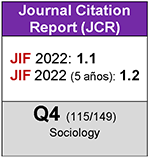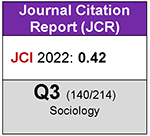Mobility and Territorial Cohesion. The Shaping of the Rural-Urban Mobility System
DOI:
https://doi.org/10.5477/cis/reis.185.23-42Abstract
The access of rural societies to welfare opportunities and resources is at the core of policy and research agendas. The persistent rural-urban gap increases the risks of exclusion and is a challenge that rural dwellers tackle by bolstering their mobility to access labour markets, resources and services. The car has become a vector in the connections and transformations that sustain rural life; however, this mobility is also a source of new fractures in social and territorial cohesion. This paper explores how the rural mobility system has been shaped and analyses its impact on these societies. The results suggest integrating the issue of mobility into rural policies from a more complex sociological perspective, addressing demographic challenges, regional development and territorial cohesion.
Downloads
References
Alloza, Mario; González-Díez, Víctor; Moral-Benito, Enrique y Tello-Casas, Patrocinio (2021). El acceso a servicios en la España rural. Madrid: Banco de España.
Berger, Michael (1979). The Devil Wagon in God’s Country. The Automobile and Social Change in Rural America, 1893-1929. Hamden (Conn.): Archon.
Binder, Julia y Matern, Antje (2020). «Mobility and Social Exclusion in Peripheral Regions». European Planning Studies, 28(6): 1049-1067. doi: 10.1080/09654313.2019.1689926 DOI: https://doi.org/10.1080/09654313.2019.1689926
Black, Niki; Scott, Karen y Shucksmith, Mark (2019). «Social Inequalities in Rural England: Impacts on Young People post-2008». Journal of Rural Studies, 68: 264-275. doi: 10.1016/j.jrurstud.2018.09.008 DOI: https://doi.org/10.1016/j.jrurstud.2018.09.008
Borgato, Stefano; Maffii, Silvia y Chiffi, Cosimo (2020). «The Rural Arena». En: T. Kuttler y M. Moraglio (eds.). Re-thinking Mobility Poverty: Understanding Users' Geographies, Backgrounds and Aptitudes (pp. 98-109). London: Routledge. doi: 10.4324/9780367333317 DOI: https://doi.org/10.4324/9780367333317-9
Brovarone, Elisabetta (2022). «Accessibility and Mobility in Peripheral Areas: A National Place-based Policy». European Planning Studies, 30(8): 1444-1463. doi: 10.1080/09654313.2021.1894098 DOI: https://doi.org/10.1080/09654313.2021.1894098
Brovarone, Elisabetta; Cotella, Giancarlo y Staricco, Lucia (eds.). (2021). Rural Accessibility in European Regions. London: Routledge. DOI: https://doi.org/10.4324/9781003083740
Büscher, Monika y Urry, John (2009). «Mobile Methods and the Empirical». European Journal of Social Theory, 12(1): 99-116. doi: 10.1177%2F1368431008099642 DOI: https://doi.org/10.1177/1368431008099642
Camarero, Luis A. (1993). Del éxodo rural y del éxodo urbano: ocaso y renacimiento de los asentamientos rurales en España. Madrid: Ministerio de Agricultura, Pesca y Alimentación.
Camarero, Luis y Oliva, Jesús (2019). «Thinking in Rural Gap: Mobility and Social Inequalities». Palgrave Communications, 5(1): 1-7. doi: 10.1057/s41599-019-0306-x DOI: https://doi.org/10.1057/s41599-019-0306-x
Canzler, Weert; Kaufmann, Vicent y Kesserling, Sven (eds.) (2008). Tracing Mobilities. Towards a Cosmopolitan Perspective. London: Routledge.
Cass, Noel; Shove, Eizabeth y Urry, John (2005). «Social Exclusion, Mobility and Access». The Sociological Review, 53(3): 539-555. doi: 10.1111%2Fj.1467-954X.2005.00565.x DOI: https://doi.org/10.1111/j.1467-954X.2005.00565.x
Catalina, Cristina; Montero, Mercedes y Vicente-Mazariegos, José l. (1989). «La familia monoparental en la España rural». En: J. Iglesias de Ussel (ed.). Actas del Primer Seminario Hispano-Francés sobre Familias Monoparentales (pp. 125-138). Madrid: Instituto de la Mujer.
Committee of the Regions (2014). Opinion of the Committee of the Regions on «Mobility in geographically and demographically challenged regions». Official Journal of the European Union. (2014/C 415/05).
Copus, Andrew K. y Lima, Philomena de (2015). Territorial Cohesion in Rural Europe. London: Routledge. DOI: https://doi.org/10.4324/9780203705001
Dargay, Joyce (2002). «Determinants of Car Ownership in Rural and Urban Areas: A Pseudo-panel Analysis». Transportation Research Part E: Logistics and Transportation Review, 38(5): 351-366. doi: 10.1016/S1366-5545(01)00019-9 DOI: https://doi.org/10.1016/S1366-5545(01)00019-9
Demolder, Eugene (1906). L’Espagne in auto – Impressions de voyage. Paris: Societe du Mercure de France.
DGT (2015). Portal estadístico. Disponible en: https://sedeapl.dgt.gob.es/WEB_IEST_CONSULTA/, acceso 22 de octubre de 2022.
Directorate-General for Internal Policies (2015). Social Inclusion in EU Public Transport. Executive Summary. European Union. (IP/B/TRAN/IC/2014-093). Disponible en:
https://www.europarl.europa.eu/RegData/etudes/STUD/2015/540351/IPOL_STU(2015)540351(SUM01)_EN.pdf
Dupuy, Gabriel (1999). «From the “Magic Circle” to “Automobile Dependence”: Measurements and Political Implications». Transport Policy, 6 (1): 1-17. doi: 10.1016/S0967-070X(98)00028-6 DOI: https://doi.org/10.1016/S0967-070X(98)00028-6
ESPON (2017). Policy Brief: Shrinking Rural Regions in Europe. Towards Smart and Innovative Approaches to Regional Development Challenges in Depopulating Rural Regions. Publicado el 23 de octubre de 2017. Disponible en:
https://www.espon.eu/sites/default/files/attachments/ESPON%20Policy%20Brief%20on%20Shrinking%20Rural%20Regions.pdf, acceso 20 de julio de 2019.
Eurofound (2022). Access to Essential Services for People on Low Incomes: Energy, Public Transport and Digital Communications. Dublin: Eurofound.
Eurostat (2021). Applying the Degree of Urbanisation. A methodological manual to define Cities, Towns and Rural Areas for international comparisons. 2021 Edition. Luxembourg: Publications Office of the European Union. 100 pp.
Farrington, John y Farrington, Conor (2005). «Rural Accessibility, Social Inclusion and Social Justice: Towards Conceptualization». Journal of Transport Geography, 13: 1-12. doi: 10.1016/j.jtrangeo.2004.10.002 DOI: https://doi.org/10.1016/j.jtrangeo.2004.10.002
Feria, José. F. (2010). «La delimitación y organización espacial de las áreas metropolitanas españolas: una perspectiva desde la movilidad residencia-trabajo». Ciudad y Territorio. Estudios Territoriales, 164: 189-210. Disponible en: https://recyt.fecyt.es/index.php/CyTET/article/view/75989
Ferrando, Carles (2020). «Automobility and the Politics of Development under Miguel Primo de Rivera: A Historicized Reading of Antonio Espina’s Luna de Copas». Journal of Spanish Cultural Studies, 21(3): 335-352. doi: 10.1080/14636204.2020.1801291 DOI: https://doi.org/10.1080/14636204.2020.1801291
Findlay, Allan; Stockdale, Aileen; Findlay, Anne y Short, David (2001). «Mobility as a Driver of Change in Rural Britain: An Analysis of the Links between Migration, Commuting and Travel to Shop Patterns». International Journal of Population Geography, 7(1): 1-15. doi: 10.1002/ijpg.201 DOI: https://doi.org/10.1002/ijpg.201
Fiorello, Davide y Zani, Loredana (2015). EU Survey on Issues Related to Transport and Mobility. Luxembourg: Publications Office of the European Union. Disponible en:
https://data.europa.eu/doi/10.2791/48322
Flink, James (1990). The Automobile Age. Cambridge MA.: MIT Press.
Gartman, David (2004). «Three Ages of the Automobile: The Cultural Logic of the Car». Theory, Culture & Society, 21(4/5): 169-195. doi: 10.1177%2F0263276404046066 DOI: https://doi.org/10.1177/0263276404046066
Gray, David; Shaw, Jonathan y Farrington, John (2006). «Community Transport, Social Capital and Social Exclusion in Rural Areas». Area, 38(1): 89-98. doi: 10.1111/j.1475-4762.2006.00662.x DOI: https://doi.org/10.1111/j.1475-4762.2006.00662.x
Guilluy, Christophe (2019). No society: El fin de la clase media occidental. Madrid: Taurus.
Halfacree, Keith H. y Rivera, María J. (2012). «Moving to the Countryside... and Staying: Lives beyond Representations». Sociologia Ruralis, 52(1): 92-114. doi: 10.1111/j.1467-9523.2011.00556.x DOI: https://doi.org/10.1111/j.1467-9523.2011.00556.x
Hansen, Stines; Newbold, Bruce; Scott, Dareen M.; Vrkljan, Brenda y Grenier, Amanda (2020). «To Drive or not to Drive: Driving Cessation amongst Older Adults in Rural and Small Towns in Canada». Journal of Transport Geography, 86: 102773. doi: 10.1016/j.jtrangeo.2020.102773 DOI: https://doi.org/10.1016/j.jtrangeo.2020.102773
Holl, Adelheid (2007). «Twenty Years of Accessibility Improvements. The Case of the Spanish Motorway Building Programme». Journal of Transport Geography, 15(4): 286-297. doi: 10.1016/j.jtrangeo.2006.09.003 DOI: https://doi.org/10.1016/j.jtrangeo.2006.09.003
Ilbery, Brian y Bowler, Ian (1998). «From Agricultural Productivism to Post-productivism». En: B. Ilbery (ed.). The Geography of Rural Change (pp. 57-84). Harlow, UK: Longman.
INE (1994). Panorámica Social de España. Madrid: Instituto Nacional de Estadística.
Jeekel, Hans (ed.) (2016). The Car-dependent Society: A European Perspective. London: Routledge. DOI: https://doi.org/10.4324/9781315614311
Jones, Peter (2011). «Conceptualising Car “Dependence”». En: K. Lucas, E. Blumenberg y R. Weinberger (eds.). Auto Motives (pp. 39-61). Bingley: Emerald. doi: 10.1108/9780857242341-002 DOI: https://doi.org/10.1108/9780857242341-002
Kaufmann, Victor; Bergman, Manfred y Joye, Dominique (2004). «Motility: Mobility as Capital». International Journal of Urban and Regional Research, 4: 745-756. doi: 10.1111/j.0309-1317.2004.00549.x DOI: https://doi.org/10.1111/j.0309-1317.2004.00549.x
Kayser, Bernard (1990). La renaissance rurale. Sociologie des campagnes du monde occidental. Paris: Armand Colin.
Kiss, Monika (2022). Understanding Transport Poverty. European Parliamentary Research Service. Members’ Research Service. PE 738.181 – Octubre de 2022.
Kline, Ronald (2000). Consumers in the Country: Technology and Social Change in Rural America. Baltimore: Johns Hopkins University Press.
Kühn, Manfred (2015). «Peripheralization: Theoretical Concepts Explaining Socio-spatial Inequalities». European Planning Studies, 23(2): 367-378. doi: 10.1080/09654313.2013.862518 DOI: https://doi.org/10.1080/09654313.2013.862518
Li, Yunheng; Westlund, Hans y Liu, Yansui (2019). «Why Some Rural Areas Decline while Some Others Not: An Overview of Rural Evolution in the World». Journal of Rural Studies, 68: 135-143. doi: 10.1016/j.jrurstud.2019.03.003 DOI: https://doi.org/10.1016/j.jrurstud.2019.03.003
Marsden, Terry; Lowe, Philip y Whatmore, Sarah (eds.) (1990). Rural Reestructuring: Global Processes and their Responses. London: David Fulton.
Mattioli, Giulio (2017). «Forced Car Ownership´ in the UK and Germany: Socio-spatial Patterns and Potential Economic Stress Impacts». Social Inclusion, 5(4): 147-160. doi: 10.17645/si.v5i4.1081 DOI: https://doi.org/10.17645/si.v5i4.1081
Milbourne, Paul y Kitchen, Laurence (2014). «Rural Mobilities: Connecting Movement and Fixity in Rural Places». Journal of Rural Studies, 34: 326-336. doi: 10.1016/j.jrurstud.2014.01.004 DOI: https://doi.org/10.1016/j.jrurstud.2014.01.004
Mitsch, Frieder; Lee, Neil y Morrow, Elizabeth (2021). «Faith no More? The Divergence of Political Trust between Urban and Rural Europe». Political Geography, 89: 102-426. doi: 10.1016/j.polgeo.2021.102426 DOI: https://doi.org/10.1016/j.polgeo.2021.102426
Moya, Carlos y Vicente-Mazariegos, José I. (1991). «Viajes y retornos de una y otra parte». Política y Sociedad, 9: 97-108.
Moseley, Malcolm (1979). Accessibility: the Rural Challenge. London: Methuen.
Moss, Joan; Jack, Claire y Wallace, Michael (2004). «Employment Location and Associated Commuting Patterns for Individuals in Disadvantaged Rural Areas in Northern Ireland». Regional Studies, 38(2): 121-136. doi: 10.1080/0034340042000190118 DOI: https://doi.org/10.1080/0034340042000190118
OECD (2016). OECD Regional Outlook 2016. Productive Regions for Inclusive Societies. Paris: OECD Publications.
Oliva, Jesús (1995). «Trabajadores manchegos en el mercado de trabajo de la construcción madrileño. La cristalización del commuting rural-urbano de larga distancia en un contexto de reestructuración rural». Agricultura y Sociedad, 75: 215-244. Disponible en: https://hdl.handle.net/2454/23182
Oliva, Jesús y Camarero, Luis (2019). «Mobility, Accessibility and Social Justice». En: M. Scott, N. Gallent y M. Gkartzios (eds.). Routledge Companion to Rural Planning (pp. 296-303). London: Routledge. DOI: https://doi.org/10.4324/9781315102375-29
Ortega y Gasset, José (1930/2006). «La moral del automóvil en España». Obras completas, 4: 318-321.
Parlamento Europeo (2022). Understanding Transport Poverty. Nota informativa. Disponible en: https://www.europarl.europa.eu/RegData/etudes/ATAG/2022/738181/EPRS_ATA(2022)738181_EN.pdf
Puyol, Rafael y Carpio, José (1977). «Los movimientos pendulares de trabajadores de la industria en la región central». Ciudad e Industria, IV Coloquio sobre Geografía (pp. 191-207). Oviedo.
Rodríguez-Pose, Andrés (2017). «The Revenge of the Places that Don’t Matter (and What to Do about It)». Cambridge Journal of Regions. Economy and Society, 11 (1): 189-209. doi: 10.1093/cjres/rsx024 DOI: https://doi.org/10.1093/cjres/rsx024
Sheller, Mimi (2018). Mobility Justice: The Politics of Movement in an Age of Extremes. New York: Verso.
Shergold, Ian y Parkhurst, Graham (2012). «Transport-related Social Exclusion amongst Older People in Rural Southwest England and Wales». Journal of Rural Studies, 28(4): 412-421. doi: DOI: https://doi.org/10.1016/j.jrurstud.2012.01.010
1016/j.jrurstud.2012.01.010 DOI: https://doi.org/10.1088/1475-7516/2012/01/010
Smith, Noel; Hirsch, Donald y Davis, Abigail (2012). «Accessibility and Capability: the Minimum Transport Needs and Costs of Rural Households». Journal of Transport Geography, 21: 93-101. doi: 10.1016/j.jtrangeo.2012.01.004 DOI: https://doi.org/10.1016/j.jtrangeo.2012.01.004
Stradling, S. G.; Meadows, M. L. y Beatty, S. (2001). «Identity and Independence: Two Dimensions of Driver Autonomy». En: G. B. Grayson (ed.). Behavioural Research in Road Safety X (pp. 1-16). Crowthorne: Transport Research Laboratory.
Urry, John (2004). «The “System” of Automobility». Theory, Culture & Society, 21: 25-39. doi: 10.1177%2F0263276404046059 DOI: https://doi.org/10.1177/0263276404046059
Volti, Rudi (2006). «Mass motorisation in Spain». The Journal of Transport History, 27(2): 116-124. doi: 10.7227%2FTJTH.27.2.10 DOI: https://doi.org/10.7227/TJTH.27.2.10
Walsh, Katherine (2012). «Putting Inequality in Its Place: Rural Consciousness and the Power of Perspective». American Political Science Review, 106(3): 517-532. doi: 10.1017/S0003055412000305 DOI: https://doi.org/10.1017/S0003055412000305
Ward, Mikel R.; Somerville, Peter y Bosworth, Gary (2013). «“Now without My Car I don’t Know what I’d Do”: The Transportation Needs of Older People in Rural Lincolnshire». Local Economy, 28(6): 553-566. doi: 10.1177/0269094213495232 DOI: https://doi.org/10.1177/0269094213495232
Ward, Neil y Brown, David L. (2009). «Placing the Rural in Regional Development». Regional Studies 43(10): 1237-1244. doi: 10.1080/00343400903234696 DOI: https://doi.org/10.1080/00343400903234696
Wik, Reynold (1980). «Early Automobility and the American Farmer». En: D. L. Lewis y L. Goldstein (eds.). The Automobile and American Culture (pp. 37-47). The University of Michigan Press.
Downloads
Published
How to Cite
Issue
Section
License
Copyright (c) 2023 Revista Española de Investigaciones Sociológicas

This work is licensed under a Creative Commons Attribution-ShareAlike 4.0 International License.
Permite Compartir — copiar y redistribuir el material en cualquier medio o formato, Adaptar — remezclar, transformar y construir a partir del material para cualquier propósito, incluso comercialmente.








